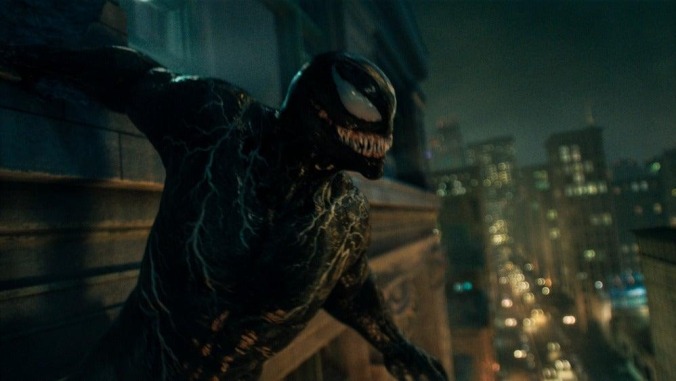Is Venom 2 doomed to be overshadowed by its own mid-credits scene?
Is Venom going to a rave, and fighting a big Woody Harrelson goo monster, simply not enough for people at this point?

[Note: This article contains significant spoilers for Venom: Let There Be Carnage.]
The after-credits sequence is the glue of the modern movie franchise spectacular—to the point where it becomes notable, maybe even a little shameful, when a big studio blockbuster opts to skip one. After all, how are we supposed to know what the next movie we need to watch is, if we don’t get a two-minute teaser of Samuel L. Jackson pulling out his magical space beeper?
And we’re not just talking about the MCU, for all that Disney’s wildly successful superhero effort was the codifier for this particular “Sorry, cleaning staff, I gotta see Mark Ruffalo Zoom in for 20 seconds” inevitability. The after- (or mid-, or pre-, etc.) credits sequence is now de rigueur in any major franchise effort, something made clear by this weekend’s Venom sequel, Let There Be Carnage.
Except—and if you’ve seen the movie already, you probably know where we’re going with this—that distinction from the MCU proper may not be quite so cut-and-dried as it used to be. Because while Let There Be Carnage ends—to the extent that anything does anymore—by wrapping up the overall story of the battle between Eddie Brock and Cletus Kasady (himself introduced in the after-credits sequence of the first Venom movie), it ends ends very differently. That is, on a mid-credits scene of Eddie and his big slimy plus-one apparently being zapped across the multiverse, to a reality where Tom Holland’s Peter Parker has just been outed as Spider-Man by J. Jonah J.K. Simmons himself.
Which means, in the span of about 120 seconds, that the most externally interesting thing about Sony’s latest big superhero blockbuster has just become its connection to a whole other studio’s library of films. The weird limbo of the Spider-Man movie rights—owned by Sony, and then lent, with what we have to assume has been some extremely careful negotiating, back to Marvel in exchange for helping build the character up—has already created the whole odd phenomenon of a Spider-Man cinematic universe in which Spider-Man himself is not allowed to appear. (Morbius: In theaters January 2022!) And now, the non-Spidey-verse is even loaning out the endings of its ostensibly standalone films, all to help shore up that team effort.
That same IP confusion has also fed into the wider curiosity surrounding the post-Endgame MCU, as questions quickly shift from “What’s next for these new or existing characters?” to “When is Marvel going to finish codifying its now largely reclaimed superhero IPs into a single property?” See also the rampant and apparently unfounded speculation that’s been running online this weekend, about supposed efforts to absorb Charlie Cox’s Netflix-based Daredevil into the Disney+ Marvel shows. And that’s to say nothing of the raging “X-Men when?!” conversations that have been running ever since the Disney-Fox merger wrapped up in 2019.
The Venom movies—while not necessarily great—are at least genuinely interesting and weird, maybe even singular, superhero movies, propelled by a devotedly odd performance from a lead actor who seems almost perversely invested in bringing his dual characters to life. But it feels almost inevitable that Let There Be Carnage is going to be quickly subsumed into the machine, becoming little more than “the one where Venom gets pulled into the MCU.”
(If that’s even exactly what’s happening here. Given the existing rights issues, it seems more likely Eddie will still be sequestered off into this December’s technically-Sony-owned Spider-Man: No Way Home, rather than following Spidey fully into cross-corporate crossover land. Even so, it’s hard not to see this as part and parcel of Marvel’s recent efforts to build its multiverse concept out, something that’s been a major focus of several of its most prominent projects of late.)
And, look: None of this is likely to hurt the film itself, at least at the box office. Let There Be Carnage is already ticking along to setting some modest mid-pandemic records, possibly even beating the original movie in the October totals. (Among other things, it looks to at least have some shot of beating Marvel’s own Shang-Chi.) But Eddie’s little trip to Spidey-land does have the effect of only heightening the impression that Marvel has taken control of big-budget filmmaking pretty much completely; after all, when you’ve set the template so thoroughly that your rivals are advertising your films and TV shows with their film-ending teasers, you must be doing something right.